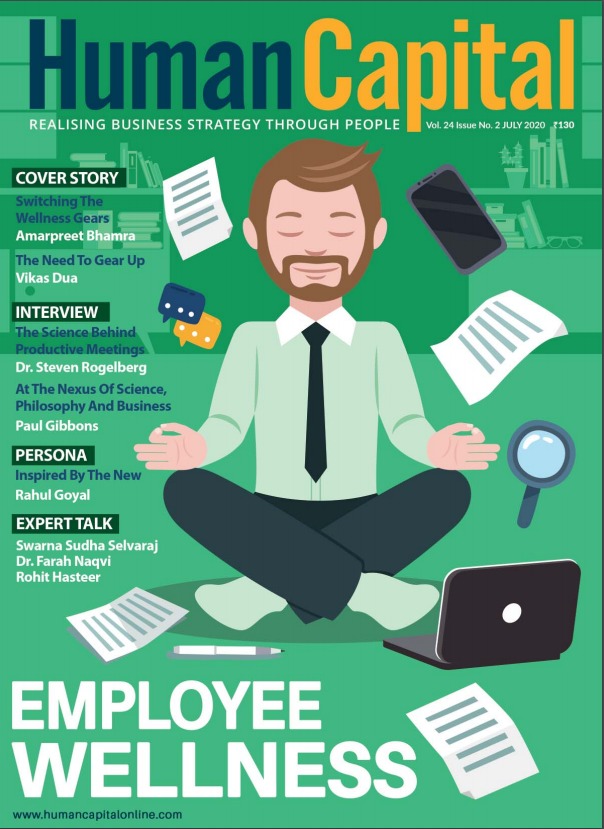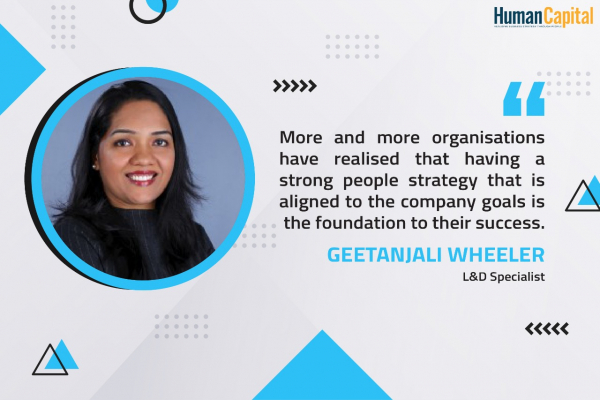Organisations must have intelligent processes, systems and tools in place to know their talent inside out. The purpose of internal talent mobility should be kept at the core and everything around it must support that objective.
In recent years, the spotlight on talent retention, fit for future skills and a proactive response to disruptive market trends has led organisations to adopt more creative measures on how they:
• Attract and Acquire talent
• Develop and equip employees within
• Reward and recognise desired performance or behaviours
• Build and retain talent in the organisation
Every organisation that intends to survive and grow will need to effectively manage its top and bottom line. The war for talent, concerns about the widening skill gap, and the need for a more agile workforce are some of the real challenges confronting organisations in the eye. More and more organisations have realised that having a strong people strategy that is aligned to the goals of the company is the foundation to their success. So, it is imperative for organisations to invest in retaining and developing talent. One of the ways in which this is being done by organisations is by moving people within to fill vacancies.
Internal Talent Mobility is hardly a new concept, and yet, very few organisations use this strategy successfully. An organisation’s talent strategy must have the right balance of sourcing internal versus external talent. It does not imply that external talent needs to match the internal talent in numbers. Rather, there needs to be an understanding of the right balance as per the business needs of today and its future. There are several studies and reports that talk about the benefits of Internal Talent Mobility. And LinkedIn’s Global Talent Trends 2020 report arguably makes for a strong case.
Some interesting insights from the said report are:-
• Employees stick around 41% longer at companies that hire from within
•By building a formalised internal recruiting programme, 63% of talent professionals believe that it will accelerate their hiring process
• With the knowledge that the existing employees already possess, 69% of talent professionals believe that it positively impacts productivity
As organisations expand and even go global, the opportunity for developing talent becomes imperative to leverage the benefit of diversity at work. Here, Diversity is not only synonymous with ‘gender’, but also with skills, experiences and background. A good internal mobility programme creates ‘deep generalists’, improving one’s understanding of the business, lateral thinking, problem-solving abilities and acquiring new skills so that it is a fit for the future. It also helps manage employee expectations of growing within an organisation as the definition of ‘growth’ should not be limited to change in bands and titles alone.
Positioning Employee Value Proposition
In this light, how can organisations leverage internal talent mobility as a key and integral part of their talent strategy?
A lot of focus is made in terms of time, money and effort to strongly position Employee Value Proposition (EVP) in the external talent market. However, the same focus or intensity is either missing or lacking when it comes to positioning EVP in the internal talent marketplace. Organisations must make a concerted effort to design Candidate Experience when attracting and acquiring internal talent. Once the talent is identified, the onboarding experience into the new role also matters the same way as it does for an externally hired candidate.
The issue of double hatting
Ever heard of someone double hatting long after a formal movement? While there could be many reasons for it, allowing this to happen often sends a different tone in the downward direction in the team. Internal talent mobility is about filling vacant roles through existing talent. It does not mean that it is less of a priority to fill the vacant role after you have found someone internally. Similarly, do we give feedback to internal candidates when they do not make it? How is that feedback tied to their development opportunities and an actual plan that helps them navigate?
According to Deloitte’s Global Human Capital Trends survey conducted in 2019, employees, in fact, find it easier to find a job in another organisation than their own. At a time where organisations want to be seen as employee centric with a strong culture, it would indeed be starkly contrasting if their very employees carry no sense of belonging. It is all the more important to introspect why this is so since organisations are fully aware that with a sense of belonging, employees bring their best to work, are better engaged and contribute immensely to the success of the organisation.
According to the same Human Capital Trends survey, among the top challenges to successfully leverage the benefits of internal talent mobility include lack of processes to identify and move employees. From the employees’ standpoint, it is about the lack of visibility on available roles. For employees, it is also about how the available roles are internally filled because it defines how they perceive the fairness of the opportunities being made available. On top of this, there is a challenge with the mindset of managers to “let go”. Who would want to let go of their top performers? Great people managers and leaders invest in their teams. This seems to be the right thing to do, and yet, it is not common to observe. Just take a moment to think about how many people managers or leaders do you know across your organisation or work experience who are excited about losing their top talent?
Another top reason why internal talent mobility fails from the employer’s standpoint is the lack of internal talent visibility i.e. what are the available skills and capabilities and where can they be found within the organisation?
The hiring managers and the HR teams need a view of talent available across businesses and geographies. Organisations must have intelligent processes, systems and tools in place to know their talent inside out. The purpose of internal talent mobility should be kept at the core and everything around it must support that objective. We can already see integrated solutions in the market that offers:
• Opportunities for employees to learn new skills or enhance the existing ones
• Opportunities for hiring managers and HR to match roles and capabilities needed
The support of technology
The technology supporting such an integration always works as a game changer in talent transformation. Now, with the pandemic, organisations are going through unprecedented levels of digital transformation. So, the need for this level of transparency in today’s hybrid or virtual world cannot be undermined.
This transparency allows employees and managers to be more proactive in their conversations pertaining to their careers and individual development. Let us assume for a moment, why is such transparency important? In my opinion, the answer to this question is connected to the possible reasons why someone would want to stay with an organisation? Employees value opportunities to earn, learn and grow and these form vital ingredients of a strong EVP. It is therefore important for organisations to take actions and materialise their intent on ground. This would go a long way in building faith within the employees and truly making the organisation a great place to work!
The success of internal talent mobility as key part of the company’s talent strategy depends upon leadership focus and collaboration between functions of Talent Acquisition, L&D, HRBPs and Hiring managers.
Is your organisation post-COVID-ready?
Trending
-
SBI General Insurance Launches Digital Health Campaign
-
CredR Rolls Out 'Life Happens' Leave For Its Employees
-
Meesho Announces 30-Week Gender-Neutral Parental Leave Policy
-
Microsoft Unveils Tech Resilience Curriculum To Foster An Inclusive Future
-
60% Indian Professionals Looking For Job Change Due To COVID: Survey
-
SpringPeople And Siemens Collaborate For Digital Transformation Push
-
86% Professionals Believe Hybrid Work Is Essential For Work Life Balance: Report
-
Almost 1 In Every 3 People's Personal Life Affected Due To Work Stress
-
Meesho Rolls Out Reset And Recharge Policy For Employees
-
80% Of Talent Leaders & Academics Say Pandemic Changed Skill Needs For Youth: Report
-
Hero Electric Rolls Out 'Hero Care' Program For Employees
-
Human Capital In Collaboration With ASSOCHAM Hosts Virtual Conference
-
IKEA India, Tata STRIVE Collaborate To Create Employability And Entrepreneurship Opportunities
-
SAP India, Microsoft Launch Tech Skilling Program for Young Women
-
DXC Technology, NASSCOM Collaborate For Employability Skills Program
-
Lenskart To Hire Over 2000 Employees Across India By 2022
-
Mindtree Launches Learn-and-Earn Program
-
Tata AIA Extends 'Raksha Ka Teeka' To Its Employees
-
Swadesh Behera Is The New CPO Of Titan
-
NetConnect Global Plans To Recruit 5000 Tech Professionals In India
-
Hubhopper Plans To Hire 60% Of Indian Podcasters By 2022
-
Corporate India Needs More Women In Leadership Roles: Report
-
Aon to Invest $30 Million and Create 10,000 Apprenticeships by 2030
-
Tech Mahindra Launches ‘Gift a Career’ Initiative for Upskilling of Youth
-
40% Women Prefer Flexible Working Options in Post-COVID World: Survey
-
3 out of 4 companies believe they can effectively hire employees virtually: Report
-
Vodafone , CGI and NASSCOM Foundation launch digital skills platform
-
Odisha: Bank, postal employees to deliver cash for elderly, differently-abled persons
-
Skill India launches AI-based digital platform for "Skilled Workforce"
-
Hiring activity declines 6.73% in first quarter: Survey
-
70% startups impacted by COVID-19 pandemic
-
Bajaj Allianz Life ropes in Santanu Banerjee as CHRO
-
Over 70 Percent MSMEs look at cutting jobs to sustain businesses
-
93 Per Cent employees stressed about returning to office post-lockdown
-
Johnson & Johnson India announces family benefits for same gender partners
-
Indian firms turning friendly towards working mothers
-
Welspun India names Rajendra Mehta as new CHRO
-
Wipro partners with NASSCOM to launch Future Skills platform



Human Capital is niche media organisation for HR and Corporate. Our aim is to create an outstanding user experience for all our clients, readers, employers and employees through inspiring, industry-leading content pieces in the form of case studies, analysis, expert reports, authored articles and blogs. We cover topics such as talent acquisition, learning and development, diversity and inclusion, leadership, compensation, recruitment and many more.
Subscribe Now












































Comment